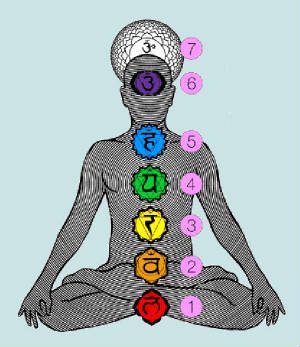Chakras
Anyone in a human body can identify these centers for themselves. They are very useful to consider, as they systematize all the inner experiences of the body in a way not found in western medicine. Western medicine, for example, knows everything about heart attacks, bypasses, angina, stints, and arterial plaque, but largely leaves heartache and love and other inner experiences of the heart to poetry and literature. However, for anyone in a body, the energies felt in this area of the body, known as the Heart or Anahata Chakra, are a profound part of life.

In Yoga and the Chakra System, the material structures of physical anatomy and the actual experience of being in a body are more closely connected. The individual can tune into these centers in his or her own body and consider what is going on there. This system validates individual experience, gives it meaning, makes it more conscious, and offers a means of managing, balancing and aligning these various energies.
Like the operations of the areas of other Chakras, the body will perform this task unconsciously, or the occupant can become more aware of this function and manage it as part of the eating, digesting and elimination process.
Ignoring it is probably not good, though some are squeamish. It is subject to being too loose or too constricted for healthy operation. Sigmund Freud famously described certain personality types as being “anal” by which he generally meant overly-disciplined and constrained in their overall approach. In yoga, Contraction and Expansiveness are seen as useful and counter-balancing opposites.
Again, some bodies might not have enough or might have a weak impulse, whereas others might be overwhelmed at times. The idea is that awareness and understanding can lead to good management and balance without repression. Again, Freud identified Genital as a second of the three personality types and felt this energy had a strong impact on personal psychology.
In the Chinese movement arts, life energy or Chi is stored there, in the area known as Dan Tien. It is the body’s physical center of gravity.
The purpose of a study of the Chakras is not to judge whether a feeling in the heart, for example, is good or bad, but to just have awareness of it so that one’s behavior is not just being driven unconsciously. Within the context of the Chakra System is the idea not that the emotions or inner experience is bad, but that all these centers can be managed by the individual.
One person’s heart might be too open; another’s might be too closed or cold. Somewhere in the middle is probably healthiest, moderated by one’s awareness.
How difficult it is to speak well, and to know what to say and when to say it. For this reason, the Buddha enumerated Right Speech as one of the steps of the Eight-fold Path. Right speech in this context is often thought to be that which is beneficial in any given moment. Awareness helps us to know when to speak, how to speak the truth, and also when silence is best.
For this reason it is known as the Third Eye in the Chakra System, not because there is some kind of hidden eye that turns outwards, but because of this ability to somehow perceive inner states. This ability can be enhanced with practice, and in a sense the intelligence of the whole body can be awakened to one’s awareness. Some activities like the breath are largely unconscious most of the time, but can be brought into awareness with some ease.
This is part of the purpose of the practice of Pranayama or breath regulation in Yoga. But consciousness attention can be brought into all areas of the body along with varying degrees of control. Just awareness alone probably enhances health. Turning the attention inward also connects one with a deeper sense of oneself.
The energy of the Crown Chakra is fantastic, yet it is not always easily available to one’s awareness. For most people, sensitivity to the awareness of this energy is developed over time through some practice like Yoga. Attunement to this center brings a sense of completeness or wholeness and liberation from the dominance of habitual and unhealthy thoughts.
From a certain perspective, all the Chakras represent energy centers in the body where sensations are produced that usually are little understood and seldom controlled but still drive our thoughts and behavior. When we turn our awareness to these centers in an organized way, we are less often overwhelmed by these feelings and emotions and in fact can begin to manage them.
Awareness of these centers is in a sense self-awareness, and the individual is more at peace. The mind is also more at peace, not driven so much by random conditioned thoughts, and behavior is more settled and conscious. Actions undertaken with this level of awareness tend to be more skillful and complete and don’t lead to more unconscious behaviors.